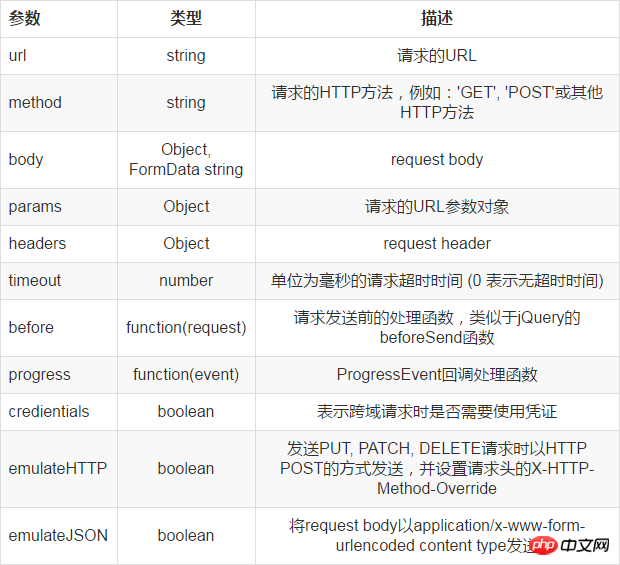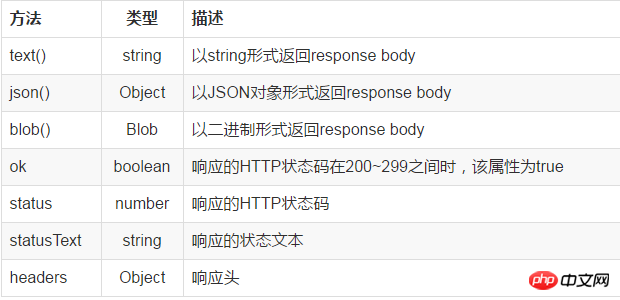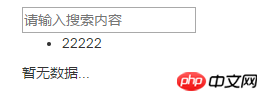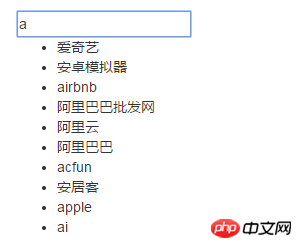How to use Vue-resource to complete interaction in VUE
This article mainly introduces the use of Vue-resource to complete interaction in VUE. The content is quite good. I will share it with you now and give it as a reference.
This article introduces the use of Vue-resource to complete interaction in VUE and shares it with everyone. The details are as follows
Using vue-resource
Introducing vue-resource
vue-resource is like $.ajax in jQuery, which is used to interact with the back-end data. vue-resource is a plug-in for vue, so Before we start using vue, we need to introduce the file vue-resource.js
<script src='js/vue.js'></script> <script src='js/vue-resource.js'></script>
Basic syntax
// 基于全局Vue对象使用http Vue.http.get('/someUrl', [options]).then(successCallback, errorCallback); Vue.http.post('/someUrl', [body], [options]).then(successCallback, errorCallback); // 在一个Vue实例内使用$http this.$http.get('/someUrl', [options]).then(successCallback, errorCallback); this.$http.post('/someUrl', [body], [options]).then(successCallback, errorCallback);
After sending the request, use the then method to process the response result. The then method has two parameters. The first parameter is the callback function when the response is successful, and the second parameter is the callback function when the response fails. .
options object

Instance:
GET request
In the following example , we make a summation function, the effect is as follows:

get method:
this.$http.get('/someUrl', [options]).then(function(response){
// 响应成功回调
}, function(response){
// 响应错误回调
});In this example, we prepared a php file, which mainly receives the parameters passed by the front desk through get, and calculates the sum of the two parameters. The code is as follows:
<?php $a=$_GET['a']; $b=$_GET['b']; echo $a+$b; ?>
html code:
<p class="container" id="box" style="margin-top:100px"> <input type="text" name="" id="" v-model="a" />+ <input type="text" name="" id="" v-model="b" /> = <input type="button" value="求和" class="btn btn-info" @click="add()"/> </p>
<script type="text/javascript">
new Vue({
el:"#box",
data:{
a:"",
b:""
},
methods:{
add:function(){
this.$http.get("get.php",{
"a":this.a,
"b":this.b
}).then(function(response){
alert(response.data)
},function(response){
alert(response.status)
}
)
}
}
})
</script>Description: response is the parameter returned by the background, which includes The following attributes:

POST request
<?php $a=$_POST['a']; $b=$_POST['b']; echo $a+$b; ?>
new Vue({
el:"#box",
data:{
a:"",
b:""
},
methods:{
add:function(){
this.$http.post("post.php",{
"a":this.a,
"b":this.b
},{
emulateJSON:true //POST请求需要将emulateJSON设置为true
}).then(function(response){
alert(response.data)
},function(response){
alert(response.status)
}
)
}
}
})JSONP
The syntax of jsonp is similar to get and post, but the data passed is different. Next, we use jsonp to complete a Baidu search function.
1. First prepare an instance interface, which is Baidu’s search interface (we can find some interfaces ourselves for testing), as follows:
https://sp0.baidu.com /5a1Fazu8AA54nxGko9WTAnF6hhy/su?wd=a&cb=show
2. Prepare layout
<p class="container" id="box" style="margin-top:100px">
<input type="text" placeholder="请输入搜索内容" />
<ul>
<li >22222</li>
</ul>
<p >暂无数据...</p>
</p>
<input type="text" placeholder="请输入搜索内容" v-model="t1" />
data:{
myData:[],
t1:""
}<input type="text" placeholder="请输入搜索内容" v-model="t1" @keyup="search()"/>
methods:{
search:function(ev){this.$http.jsonp("https://sp0.baidu.com/5a1Fazu8AA54nxGko9WTAnF6hhy/su",{
"wd":this.t1
},{
jsonp:"cb" //callback名字,默认是callback
}).then(function(response){
this.myData=response.data.s
},function(response){
alert(response.status)
}
)
}
}
<p class="container" id="box" style="margin-top:100px">
<input type="text" v-model="t1" @keyup="search($event)" @keydown.down.prevent="changeDown($event)" @keydown.up.prevent="changeup()"/>
<ul>
<li v-for="(value, index) in myData" :class="{gray:index==now}">{{value}}</li>
</ul>
<p v-show="myData.length==0">暂无数据...</p>
</p>/*data数据*/
data:{
myData:[],
t1:"",
now:-1
}
/*上下键的方法*/
changeDown:function(){
this.now++;
if(this.now==this.myData.length){
this.now=-1;
}
this.t1=this.myData[this.now];
},
changeup:function(){
this.now--;
if(this.now==-2){
this.now=this.myData.length-1;
}
this.t1=this.myData[this.now];
}
初识vue
<p class="container" id="box" style="margin-top:100px">
<input type="text" v-model="t1" @keyup="search($event)" @keydown.down.prevent="changeDown($event)" @keydown.up.prevent="changeup()"/>
<ul>
<li v-for="(value, index) in myData" :class="{gray:index==now}">{{value}}</li>
</ul>
<p v-show="myData.length==0">暂无数据...</p>
</p>
Vue implements the function of cropping images and uploading them to the server.
Vue implements two-way binding method
The above is the detailed content of How to use Vue-resource to complete interaction in VUE. For more information, please follow other related articles on the PHP Chinese website!

Hot AI Tools

Undresser.AI Undress
AI-powered app for creating realistic nude photos

AI Clothes Remover
Online AI tool for removing clothes from photos.

Undress AI Tool
Undress images for free

Clothoff.io
AI clothes remover

AI Hentai Generator
Generate AI Hentai for free.

Hot Article

Hot Tools

Notepad++7.3.1
Easy-to-use and free code editor

SublimeText3 Chinese version
Chinese version, very easy to use

Zend Studio 13.0.1
Powerful PHP integrated development environment

Dreamweaver CS6
Visual web development tools

SublimeText3 Mac version
God-level code editing software (SublimeText3)

Hot Topics
 1377
1377
 52
52
 How to add functions to buttons for vue
Apr 08, 2025 am 08:51 AM
How to add functions to buttons for vue
Apr 08, 2025 am 08:51 AM
You can add a function to the Vue button by binding the button in the HTML template to a method. Define the method and write function logic in the Vue instance.
 How to reference js file with vue.js
Apr 07, 2025 pm 11:27 PM
How to reference js file with vue.js
Apr 07, 2025 pm 11:27 PM
There are three ways to refer to JS files in Vue.js: directly specify the path using the <script> tag;; dynamic import using the mounted() lifecycle hook; and importing through the Vuex state management library.
 How to use bootstrap in vue
Apr 07, 2025 pm 11:33 PM
How to use bootstrap in vue
Apr 07, 2025 pm 11:33 PM
Using Bootstrap in Vue.js is divided into five steps: Install Bootstrap. Import Bootstrap in main.js. Use the Bootstrap component directly in the template. Optional: Custom style. Optional: Use plug-ins.
 How to use watch in vue
Apr 07, 2025 pm 11:36 PM
How to use watch in vue
Apr 07, 2025 pm 11:36 PM
The watch option in Vue.js allows developers to listen for changes in specific data. When the data changes, watch triggers a callback function to perform update views or other tasks. Its configuration options include immediate, which specifies whether to execute a callback immediately, and deep, which specifies whether to recursively listen to changes to objects or arrays.
 How to return to previous page by vue
Apr 07, 2025 pm 11:30 PM
How to return to previous page by vue
Apr 07, 2025 pm 11:30 PM
Vue.js has four methods to return to the previous page: $router.go(-1)$router.back() uses <router-link to="/" component window.history.back(), and the method selection depends on the scene.
 Vue realizes marquee/text scrolling effect
Apr 07, 2025 pm 10:51 PM
Vue realizes marquee/text scrolling effect
Apr 07, 2025 pm 10:51 PM
Implement marquee/text scrolling effects in Vue, using CSS animations or third-party libraries. This article introduces how to use CSS animation: create scroll text and wrap text with <div>. Define CSS animations and set overflow: hidden, width, and animation. Define keyframes, set transform: translateX() at the beginning and end of the animation. Adjust animation properties such as duration, scroll speed, and direction.
 How to query the version of vue
Apr 07, 2025 pm 11:24 PM
How to query the version of vue
Apr 07, 2025 pm 11:24 PM
You can query the Vue version by using Vue Devtools to view the Vue tab in the browser's console. Use npm to run the "npm list -g vue" command. Find the Vue item in the "dependencies" object of the package.json file. For Vue CLI projects, run the "vue --version" command. Check the version information in the <script> tag in the HTML file that refers to the Vue file.
 How to use vue traversal
Apr 07, 2025 pm 11:48 PM
How to use vue traversal
Apr 07, 2025 pm 11:48 PM
There are three common methods for Vue.js to traverse arrays and objects: the v-for directive is used to traverse each element and render templates; the v-bind directive can be used with v-for to dynamically set attribute values for each element; and the .map method can convert array elements into new arrays.




